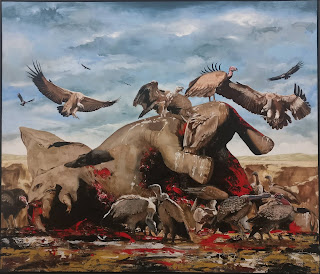PRIMITIVE @ A+ WORKS of ART
Centuries ago, what did visual art illustrate? Reverential icon? Metaphorical lessons? Decaying reminders? Can an artwork be defined as, a material object representing subjective truths? Standing outside this art gallery in Sentul, I face an oil painting, of one Roman philosopher’s marble bust from the Musei Capitolini. Inside the gallery, a sculpture family of porcelain pigs exhibit grotesque expressions. Nearby, large hangings display one peeing dog in a barren landscape, and a picture of a dead elephant being feasted on by vultures. A giant tombstone, and a taxidermy crow perched on a hoe, lie among a long patch of soil. Facing it are three acrylic paintings of monkeys in funny poses. How should the visitor look at these depictions of animals, and who is that in the window?
 |
| Installation snapshot of See No Evil, Hear No Evil, Speak No Evil (2013/2017) |
After some looking, I conclude that the exhibited paintings are drawn from images found on the internet (the exception being ‘Dogged’, a work completed 15 years ago). Ahmad Fuad Osman is well-known as a painter, and although his signature bold brush strokes remain, these paintings look like mere impressions of digital images. In a radio interview, the artist revealed that the two philosophical quotes seen at “PRIMITIVE”, were shared to him via WhatsApp texts. The quote on the epitaph shown here, is from Ayn Rand’s novel Atlas Shrugged, which hidden preceding sentence states that “(m)oney is the barometer of a society’s virtue.”
 |
| Installation snapshot of [l] Dogged (2003); [r] Mak Bapak Borek Anak-anak pun Rintik (2015/2018) |
Less we think that the artist is quoting Objectivist philosophy as truth, I note that Ayn – who espouses “the concept of man as a heroic being” and rational individualism – also wrote in Capitalism: The Unknown Ideal that, “(c)ollectivism is the tribal premise of primordial savages who, unable to conceive of individual rights, believed that the tribe is a supreme, omnipotent ruler, that it owns the lives of its members and may sacrifice them whenever it pleases.” The tombstone exhibit ‘Déjà vu’ is made from lightweight insulation foam and engraved PVC boards; Visually the object & text combination is heavy, yet in fact both things have been taken out of context in its presentation.
 |
| Installation snapshot of [foreground] The Birth of Tragedy (2014); [background] Déjà vu (2017) |
That ‘Déjà vu’ lies near an exhibit referencing Friedrich Nietzsche and biblical murder, amplifies the ethical conundrum one encounters when trying to interpret the work. The suspicion of fake news being propagated here, is confirmed after a Google search. White laser-cut acrylic letters spell out a quote about “taught falsehoods” by Plato, which should be attributed to George France Train, a former railroad mogul who campaigned to be the President of the United States in 1872. Displayed together with the bust portrait in golden frames under the title ‘Plato (427 – 347 BC)', the conceit is complete. Diving down the rabbit hole, I further suspect the original bust – a copy, no less – already had its nose broken off, and this mimicked image is a digital restoration…
 |
| Installation snapshot of Plato (427 – 347 BC) (2017) |
While curator Syed Muhd Hafiz opines in his catalogue essay, that “PRIMITIVE” deals with the lack of a (Malay) ‘hero’, I think Fuad’s exhibits are an investigation into the authority of the visual image. The pairing of beautiful object (or looks like), with words of wisdom (or sounds like), project a strong commentary that abnegates the visual mode. How does an artwork look like, what it really is, what does it mean – and everything that is not. Fake news is a symptom, blind trust in human expression is the disease. The three wise monkeys, which origins are traced to the Japanese expression 見ざる, 聞かざる, 言わざる (with no references to ‘evil’), offer a good reminder about human nature. Ignorance and fallacy are human, primitive traits as they are.
 |
| All That Is Solid Melts Into Air (2018) |
"Plato was discoursing on his theory of ideas and, pointing to the cups on the table before him, said while there are many cups in the world, there is only one idea of a cup, and this cupness precedes the existence of all particular cups. "I can see the cup on the table," interrupted Diogenes, "but I can't see the cupness". "That's because you have the eyes to see the cup," said Plato, "but", tapping his head with his forefinger, "you don't have the intellect with which to comprehend cupness." Diogenes walked up to the table, examined a cup and, looking inside, asked, "Is it empty?" Plato nodded. "Where is the emptiness which precedes this empty cup?" asked Diogenes. Plato allowed himself a few moments to collect his thoughts, but Diogenes reached over and, tapping Plato's head with his finger, said "I think you will find here is the emptiness."
- Anecdote from Aelien, Varia Historia
 |
| Déjà vu (2017) [picture from "PRIMITIVE" exhibition catalogue, p.29] |
Comments
Post a Comment